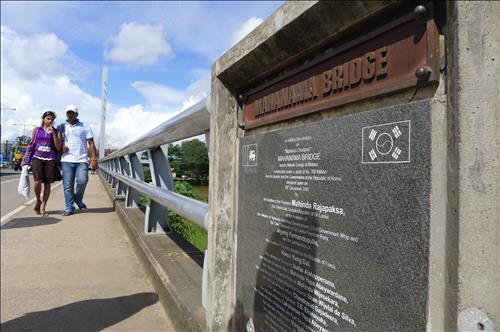By Kim Soo-yeon
MATARA/HAMBANTOTA, Sri Lanka, Dec. 4 (Yonhap) -- Shantha Punchihewa, a 48-year-old Sri Lankan in Matara, still remembers the day after Christmas Day 10 years ago when a devastating tsunami claimed the lives of his younger sister and two nephews.
Located on the southern coast of Sri Lanka, Matara was hit hard by the tsunami triggered by a powerful earthquake off the west coast of Indonesia's Sumatra Island in 2004. The ensuing tidal waves killed about 1,800 residents in Matara, officials say.
The tsunami also severely damaged a two-lane bridge across the Nilwala Ganga that bisects Matara, disrupting the mobility and daily work of Matara's citizens.
Since then, Mahanama Bridge, which is now being expanded into six lanes, has become a symbol of reconstruction for the tsunami-scarred city with assistance of the Korea International Cooperation Agency (KOICA), Seoul's official development assistance (ODA) body.
 This photo shows Mahanama Bridge in Sri Lanka. In 2007, South Korea built the bridge with grant aid to help people recover from the tsunami that hit Matara in 2004. (Yonhap)
This photo shows Mahanama Bridge in Sri Lanka. In 2007, South Korea built the bridge with grant aid to help people recover from the tsunami that hit Matara in 2004. (Yonhap)
"The tsunami made it hard for people to cross the bridge for daily work and to even receive aid from other countries," said Punchihewa. "But the restoration of the bridge has made (the) lives of Matara's citizens... better. I appreciate South Korea for it."
KOICA injected some 7 billion won (US$6.3 million) in grant aid to rebuild the 90-meter bridge between 2005 and 2007 in a bid to help citizens in Matara cope with the aftereffects of the tsunami.
KOICA injected some 7 billion won (US$6.3 million) in grant aid to rebuild the 90-meter bridge between 2005 and 2007 in a bid to help citizens in Matara cope with the aftereffects of the tsunami.
"The role of the bridge is important here as it links Matara to another city Hambantota (in the southern area of Sri Lanka)," Sosindra Handunge, mayor of Matara, told a group of reporters.
"The affected families suffered mentally, but I would say that the construction of the bridge has helped Matara residents forget the painful memory," he added.
Under the wing of the foreign ministry, KOICA, founded in 1991, is one of the two main entities that implement Seoul's grant aid for developing countries. The Export-Import Bank of Korea under the finance ministry provides soft loans to such nations with very low interest rates.
South Korea has been widely called the first country in the world to go from being an aid recipient to a donor country. In the past, the word "Korea" in Sri Lanka used to mean areas where poor people live, residents say.
Seoul has provided ODA to 44 developing countries with the aim of raising the proportion of its grant aid to its gross national income (GNI) to over 0.2 percent by 2015. The ratio currently stands at 0.13 percent.
South Korea extended a total of $1.74 billion in ODA in 2013, making it the world's 16th-largest donor among 28 members of the Organization for Economic Cooperation and Development's Development Assistance Committee (DAC), the body of major ODA donors.
KOICA has offered an accumulative $97 million in ODA to Sri Lanka between 1991 and 2013, according to the agency. The tsunami disaster in 2004 led KOICA to boost its assistance to the South Asian country.
Punchihewa said that before the tsunami occurred, Matara used to be a big and vibrant city.
"Since then, the city of Hambantota has grown faster," he said, adding that the sea waves and the bridge have changed the lives of residents in Matara.
Hambantota on the southern coast, about two hours' drive east of Matara, is also one of the cities where South Korea has been involved in major development projects.
Seoul has offered 7.2 billion won in ODA to help build the main building of an international convention center as part of its efforts to support the tsunami-hit southern areas. A South Korean builder earned an additional contract worth 14.6 billion won to set up the annex to the 1,500-seat convention center, the largest in Sri Lanka.
 An international convention center built with South Korea's official development assistance in Hambantota, Sri Lanka. (Yonhap)
An international convention center built with South Korea's official development assistance in Hambantota, Sri Lanka. (Yonhap)
Sri Lankan President Mahinda Rajapaksa has been trying to develop Hambantota, also his hometown, into the second-largest city by making it a strategic hub port in the Indian Ocean.
China and Japan have been aggressively reaching out to countries in South Asia in an apparent bid to boost their maritime and economic interests.
Japan has ranked first in terms of its assistance to Sri Lanka out of the OECD/DAC donor countries. But, unofficially, China is presumed to be the No. 1 aid donor to Colombo by providing about $600 million per year between 2005 and 2013, according to the KOICA.
Beijing has actively participated in large infrastructure projects in Sri Lanka as part of its "a string of pearls" strategy to counter India and win economic influence. Hambantota International Airport was built with Chinese loans in 2013.
Kim In, vice president of the KOICA, said that South Korea has started late as an aid donor, but many developing countries are attracted by Seoul's readiness to share its experience of economic development and strategy to win hearts and minds.
"It is important to be very attentive to the needs of recipient countries or to resolve their nagging problems when offering ODA," Kim said.
Kim said that South Korea should continue to develop aid strategies tailored to recipients, adding that a culture of evaluating ODA projects from a long-term perspective is also necessary.




No comments:
Post a Comment